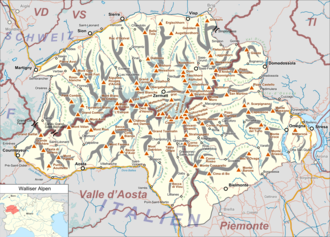| Mountain pass | location | type | elevation |
|---|
| Sesiajoch | Zermatt to Alagna | snow | 4,424 | 14,515 |
| Domjoch | Randa to Saas-Fee | snow | 4,286 | 14,062 |
| Lisjoch | Zermatt to Gressoney-La-Trinité | snow | 4,277 | 14,033 |
| Mischabeljoch | Zermatt to Saas-Fee | snow | 3,856 | 12,651 |
| Alphubel Pass | Zermatt to Saas-Fee | snow | 3,802 | 12,474 |
| Adler Pass | Zermatt to Saas-Fee | snow | 3,798 | 12,461 |
| Moming Pass | Zermatt to Zinal | snow | 3,745 | 12,287 |
| Schwarztor | Zermatt to Ayas | snow | 3,741 | 12,274 |
| Ried Pass | Sankt-Niklaus to Saas-Fee | snow | 3,597 | 11,800 |
| Neues Weisstor | Zermatt to Macugnaga | snow | 3,580 | 11,746 |
| Allalin Pass | Zermatt to Saas-Fee | snow | 3,570 | 11,713 |
| Col de Valpelline | Zermatt to Aosta | snow | 3,562 | 11,687 |
| Biesjoch | Randa to Turtmann | snow | 3,549 | 11,644 |
| Triftjoch | Zermatt to Zinal | snow | 3,540 | 11,615 |
| Col du Sonadon | Bourg-Saint-Pierre to the Val de Bagnes | snow | 3,489 | 11,447 |
| Col d'Herens | Zermatt to Evolène | snow | 3,480 | 11,418 |
| Col Durand | Zermatt to Zinal | snow | 3,474 | 11,398 |
| Col des Maisons Blanches | Bourg-Saint-Pierre to the Val de Bagnes | snow | 3,426 | 11,241 |
| Col de Bertol | Arolla to the Col d'Herens | snow | 3,414 | 11,200 |
| Col du Mont Rouge | Val de Bagnes to the Val d'Hérémence | snow | 3,341 | 10,962 |
| Theodulpass | Zermatt to Valtournenche | snow | 3,322 | 10,899 |
| Col de Tracuit | Zinal to Turtmann | snow | 3,252 | 10,670 |
| Zwischbergen Pass | Saas-Fee to Gondo | snow | 3,248 | 10,657 |
| Col d'Oren | Val de Bagnes to the Valpelline | snow | 3,242 | 10,637 |
| Col de Seilon | Val de Bagnes to the Val d'Hérémence | snow | 3,200 | 10,499 |
| Col du Cret | Val de Bagnes to the Val d'Hérémence | snow | 3,148 | 10,329 |
| Col de Valcournera | Valtournenche to the Valpelline | snow | 3,147 | 10,325 |
| Col de Collon | Arolla to Aosta | snow | 3,130 | 10,270 |
| Col de Valsorey | Bourg-Saint-Pierre to Aosta | snow | 3,113 | 10'214 |
| Col de Chermontane | Val de Bagnes to Arolla | snow | 3084 | 10,119 |
| Cimes Blanches | Valtournenche to Ayas | bridle path | 2,980 | 9,777 |
| Col de Torrent | Evolène to the Val de Torrent | bridle path | 2,924 | 9,593 |
| Augstbord Pass | Sankt-Niklaus to Turtmann | bridle path | 2,893 | 9,492 |
| Col de Crête Sèche | Val de Bagnes to the Valpelline | snow | 2,888 | 9,475 |
| Col d'Olen | Alagna to Gressoney | bridle path | 2,871 | 9,420 |
| Monte Moro | Saas-Fee to Macugnaga | bridle path | 2,862 | 9,390 |
| Pas de Chevres | Arolla to the Val d'Hérémence | footpath | 2,851 | 9,354 |
| Antrona Pass | Saas-Fee to Antrona | bridle path | 2,844 | 9,331 |
| Col de Sorebois | Zinal to the Val de Torrent | bridle path | 2,825 | 9,269 |
| Col de Vessona | Valpelline to Nus | footpath | 2,794 | 9,167 |
| Fenêtre de Durand | Val de Bagnes to Aosta | bridle path | 2,786 | 9,141 |
| Z'Meiden Pass | Zinal to Turtmann | bridle path | 2,772 | 9,095 |
| Turlo Pass | Alagna to Macugnaga | footpath | 2,736 | 8,977 |
| Fenêtre de Ferret | Great St Bernard to the Swiss Val Ferret | bridle path | 2,699 | 8,855 |
| Bettaforca Pass [3] (Bättforko) | Ayas to Gressoney-La-Trinité | bridle path | 2,676 | 8,780 |
| Col Serena | Great St Bernard to Morgex | footpath | 2,538 | 8,327 |
| Col Ferret | Courmayeur to Orsières | bridle path | 2,533 | 8,311 |
| Col de Valdobbia | Gressoney to the Val Sesia | bridle path | 2,479 | 8,134 |
| Great St Bernard | Martigny to Aosta | road | 2,472 | 8,111 |
| Col de Moud | Alagna to Rima | bridle path | 2,323 | 7,622 |
| Col d'Egua | Rima to the Valle Anzasca | bridle path | 2,236 | 7,336 |
| Simplon Pass | Brig to Domodossola | road | 2,009 | 6,592 |
| Bocchetta del Croso | Piedicavallo to Valsesia | bridle path | 1,941 | 6,374 |
| Baranca Pass | Varallo to the Val Anzasca | bridle path | 1,820 | 5,971 |










